What Are Dental Crowns/Bridges Made From?
- Dental crowns & bridges are usually made from a hard, white substance that can be modified by adding colour or shading to give a more realistic appearance of a natural tooth.
- A bridge is made up of a crown next to a missing tooth, or one crown either side of missing teeth, with a false tooth or teeth in between which restores the space caused by missing teeth.
- Crowns and bridges can be made from a number of different materials and your dentist is the best person to advise you as to which best material is suitable depending on the type of crown or bridge required and where it is being placed in your mouth.
How To Get Dental Crowns & Bridges Fitted in Essex?
- Preparing The Tooth For A Crown or Bridge
- Fitting The Dental Crown or Bridge
- How Long Do Dental Crowns/Bridges Last?
Firstly the tooth is prepared under local anaesthetic so the crown or bridge is able to be fitted on the tooth after which moulds (impressions) are taken of both your upper and lower teeth.
This is done so that the technician making your crown or bridge is able to construct it correctly so it will sit within your bite. At this appointment, the dentist will also choose the shade for the crown or bridge which most closely matches the natural shade of your teeth.
The impressions are then sent to a dental lab, where the technician will build the crown or bridge. This normally takes approximately two weeks so in the meantime your dentist may put a temporary crown or bridge on your tooth or teeth to protect during this time.
At the second visit, the temporary restoration is removed and the new crown or bridge fitted.
If it is taken care of properly a crown or bridge can last for many years. The crown or bridge itself cannot decay but the teeth underneath it can.
It is therefore extremely important to make sure that you clean around the crown or bridge as you would your own teeth and use to use floss or interdental brushes to clean in between the crown or bridge and adjacent teeth.
It may be necessary for you to see the dental hygienist more regularly to ensure that the restorations are kept in good condition
